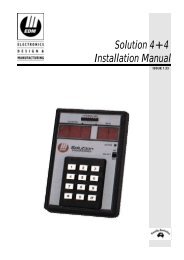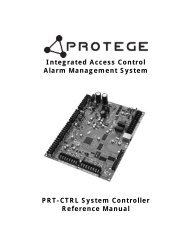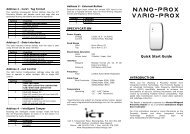SecureStream IP Receiver - Security Help Desk
SecureStream IP Receiver - Security Help Desk
SecureStream IP Receiver - Security Help Desk
Create successful ePaper yourself
Turn your PDF publications into a flip-book with our unique Google optimized e-Paper software.
Working with the Details tab<br />
The Details tab is the first tab in the configuration editor<br />
Trained Installation Technicians may complete the fields in the Details tab.<br />
Step<br />
Instructions<br />
1 Open the configuration editor as described in Overview on page 15.<br />
2 Optional — In the Description field, type a description as you wish it to appear in the<br />
Applications folder list.<br />
3 In the <strong>SecureStream</strong> <strong>IP</strong> Challenger port field, Type a number for the <strong>IP</strong> port<br />
<strong>SecureStream</strong> <strong>IP</strong> ‘listens’ for event traffic from Challenger panels on the network. This<br />
must match the 'TCP/<strong>IP</strong> Port Number' setting in Installer menu 47 on the Challenger. The<br />
default setting is 3001.<br />
4 In the Application Management <strong>IP</strong> Port Base field, type a port number for the <strong>IP</strong> port<br />
<strong>SecureStream</strong> <strong>IP</strong> listens to for commands from the GUI applications. The default is 3020.<br />
5 In the <strong>Receiver</strong> Number field, type a number from 0-99 (supplied by the monitoring<br />
station staff) to set the first two digits of the address part of the CID message. The<br />
monitoring computer uses the receiver number to identify this <strong>SecureStream</strong> <strong>IP</strong> <strong>Receiver</strong>,<br />
and to differentiate between other <strong>SecureStream</strong> <strong>IP</strong> <strong>Receiver</strong>s if multiple receiver units are<br />
used.<br />
If the Monitoring computer only uses the first of these two digits to identify the receiver,<br />
also check the Computer Ignores 2 nd <strong>Receiver</strong> Digit check box.<br />
6 In the Error Reporting Circuit # field, type the circuit number that identifies the<br />
<strong>SecureStream</strong> <strong>IP</strong> to the monitoring station when the <strong>SecureStream</strong> must report things<br />
about its internal operation (e.g. <strong>IP</strong> license expired). Use a four-digit number supplied by<br />
the monitoring station staff.<br />
7 Check the Watchdog enabled option if you want the backup <strong>SecureStream</strong> <strong>IP</strong> <strong>Receiver</strong> to<br />
change its heartbeat rate to the main <strong>SecureStream</strong> <strong>IP</strong> <strong>Receiver</strong> heartbeat rate if the main<br />
<strong>SecureStream</strong> <strong>IP</strong> fails.<br />
8 In the Sequence Check Timeout field, enter the number of seconds a backup or disaster<br />
<strong>SecureStream</strong> <strong>IP</strong> <strong>Receiver</strong> should wait to receive clarification from its immediate superior<br />
<strong>SecureStream</strong> <strong>IP</strong> <strong>Receiver</strong> of an out-of-sequence event before generating an ‘Out Of<br />
Sequence’ alarm.<br />
9 Click the (Re)Enrol button at the base of the details tab if the max silence/heartbeat<br />
details for a panel have been changed in management software to ensure the details in<br />
<strong>SecureStream</strong> <strong>IP</strong> match.<br />
10 Optional backup functions:<br />
• Update Status refreshes any live data on the page.<br />
• Backup <strong>IP</strong> saves <strong>SecureStream</strong> <strong>IP</strong>’s Challenger database, including the <strong>IP</strong> address,<br />
security password, encryption key and computer address to a file on a floppy disk.<br />
Note that <strong>SecureStream</strong> <strong>IP</strong> is continuously updating a hard disk-based copy of this<br />
data which it will use to automatically rebuild its database in the event of a<br />
catastrophe (e.g. the SQL database is deleted). You can use Backup <strong>IP</strong> as a safety<br />
precaution to back up a Challenger database, or to transfer a Challenger database<br />
from one <strong>SecureStream</strong> <strong>IP</strong> <strong>Receiver</strong> to another. (Caution! Make sure you restore the<br />
correct Challenger database, as the restore function overwrites the Challenger<br />
database on the <strong>SecureStream</strong> <strong>IP</strong> <strong>Receiver</strong> to which you restore the file).<br />
• Restore <strong>IP</strong>. Click the Restore <strong>IP</strong> button to copy a Challenger database from the disk<br />
to restore or overwrite a Challenger database to a <strong>SecureStream</strong> <strong>IP</strong> <strong>Receiver</strong>.<br />
11 Click the Save icon.<br />
16 <strong>SecureStream</strong> <strong>IP</strong> <strong>Receiver</strong> Installation & Programming Guide 2.0
















